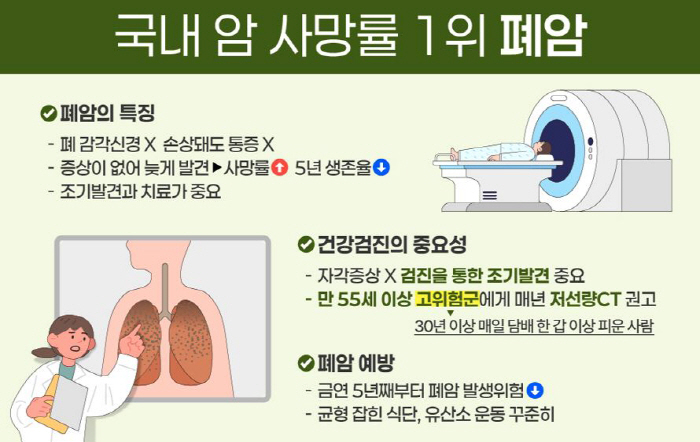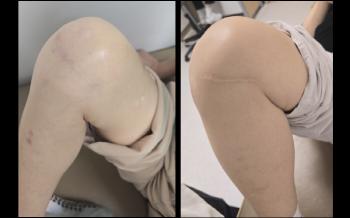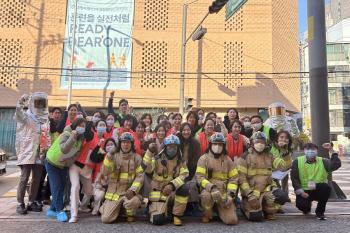Lungs that don't talk even if they're sick...Low-dose CT recommended for smokers over 55 years of age
|
According to national cancer registration statistics, lung cancer was the third most common after thyroid cancer and colon cancer as of 2022.
Of the 147,468 cancer patients, 21,646 were male, and 16,67 were female, almost twice as many as lung cancer, and the incidence of lung cancer was the highest among those aged 65 or older.
"Lung cancer has a high mortality rate and a low five-year survival rate as many cases of lung cancer are detected late because there are no special symptoms even after the disease has progressed considerably," said H Plus Yangji Hospital, a specialist at the Democratic Institute of Respiratory Medicine. "Early detection and treatment are important because the survival rate decreases by 36% from 5 to 10 years sick to 10 to 15 years after surgery, and 88% over 20 years."
◇ Lung sensory nerves are not aware of pain, which increases the disease
Lung is an essential organ responsible for breathing that absorbs oxygen in the air and emits carbon dioxide. Lung cancer is a malignant tumor in the lungs that can interfere with breathing and spread throughout the body such as the liver, bones, kidneys, and brain through blood. The lungs do not have sensory nerves, so there is no pain even if the inside of the lungs is damaged, and they do not feel symptoms even after the fourth period.
Lung cancer is divided into primary lung cancer that occurs in the lung itself and metastatic lung cancer that has spread to other sites depending on the site of occurrence. Primary lung cancer is divided into non-small cell lung cancer and small cell lung cancer according to cancer cell type, and 8 out of 10 patients with lung cancer are non-small cell lung cancer. Non-small cell lung cancer grows slowly, so it can be cured by surgery in the early stages. However, due to the nature of lung cancer without prognostic symptoms, early diagnosis is difficult and surgery is possible only in one-third of the total. Even if treatment is successful in a state of progression, the probability of recurrence is high.
The most common cause of lung cancer is smoking. Smokers are nearly 20 times more likely to develop lung cancer than non-smokers. Tobacco contains more than 50 carcinogens, and 70% of lung cancers are known to be related to smoking. In addition, people who are exposed to secondhand smoke and carcinogens such as cooking fumes, air pollution, fine dust, radon, asbestos, and gravestones are more likely to develop lung cancer. Due to the high genetic factors, the incidence rate increases two to three times if you have a family history of lung cancer.
◇Early detection rate through examination is 68.4% and the cure rate is also high
There are various treatments for lung cancer, such as surgery, radiation therapy, chemotherapy, targeted therapy, and immunotherapy, but fundamentally removing cancer is the most obvious method. Not everyone is applicable because the patient's condition, such as age, lung function, physical ability, and underlying disease, but if the lesion and metastatic periphery are surgically resected in the early stages, the cure rate is high.
Therefore, if it is difficult to detect due to subjective symptoms, it is important to detect early through constant examination. Currently, the country recommends low-dose CT every year to high-risk groups who have smoked more than one pack of cigarettes every day for more than 30 years in the age group 55 and older. Low-dose CT is a test method used in the lung cancer screening pilot project conducted by the Ministry of Health and Welfare since 2017, and according to the Korean Association for Lung Cancer, the early detection rate through examination is 68.4%.
In real life, smoking cessation is the best precaution for smokers. If you quit smoking, the risk of lung cancer starts to decrease from about five years, and if you quit smoking for about 15 years, it can be reduced to 1.5 to 2 times that of non-smokers. It is also good to keep a balanced diet including fruits and vegetables and aerobic exercise to strengthen the respiratory system.
"Lung cancer is a disease with a high mortality rate, but it has been rising rapidly, with five-year survival rates nearly tripling in the last 30 years," said a Democratic researcher"If you detect and treat it quickly, the prognosis is good, so if you have been smoking long-term, or have a bad lung, and if you have a lung cancer patient in your family, you should make a living examination." he advised.
|
|
This article was translated by Naver AI translator.






